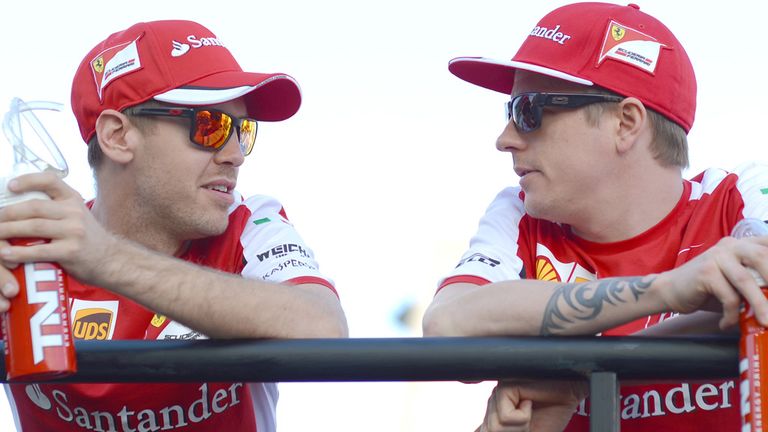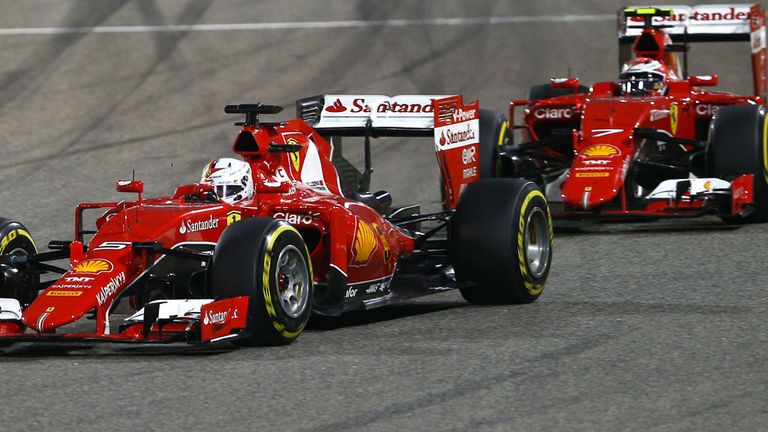Examining Raikkonen v Vettel - and why the 2015 Ferrari suits both
Sky F1's Mark Hughes examines the battle for supremacy at Ferrari, why the SF15-T suits both Sebastian Vettel and Kimi Raikkonen, and the subtle changes that inspire performance gains...
Tuesday 28 April 2015 12:27, UK
The performances of Ferrari drivers Sebastian Vettel and Kimi Raikkonen has been particularly illuminating in the first four races of the season.
As ever with drivers of this calibre, differences between them are invariably accounted not so much by any significant difference in their ability but in how the way they naturally drive dovetails with the traits of the car. This is apparent in the comparison between them – just as it is in their improvement over last year.
In the SF15-T, both drivers are able to express themselves better than they were able to last year in the Red Bull RB10 and Ferrari F14T respectively. The difference is particularly stark in the case of Raikkonen, for his 2014 car was much more flawed than Vettel’s, but both proved unable in 2014 to adapt their driving around those car flaws – in a way that their team-mates Daniel Ricciardo and Fernando Alonso were able to.
In a car with much more benign traits, one in which technical director James Allison has prioritised progressive, accessible and consistent – rather than peak – downforce, they are once more able to let their driving flow. Both are driving much closer to their own potential than was the case last year.
How that would compare against those two team-mates were they all in this year’s Ferrari cannot be known with any certainty, but you can bet that any differences would be much smaller than last year.
The performance gaps between Ricciardo-Vettel and Alonso-Raikkonen last year were more about the shortfall in adaptation shown by Vettel and, particularly, Raikkonen than about their ultimate potential.
At Ferrari this principle could even be seen playing out live many times: whenever the switch was made from a hard or medium to a soft or super-soft tyre, Raikkonen’s deficit to Alonso was always hugely reduced or occasionally even overcome entirely. If it was only about their ultimate potential, the gap between them would have been unchanged.
Part of being a great driver is the ability to adapt to different car traits – something at which Alonso is masterful - and the difficulties Vettel and Raikonen had in doing this last year already damages their claims to true all-encompassing greatness. But that is not to say that such drivers cannot reach levels of greatness when they have what they need from the car – as Vettel and Raikkonen have each done many, many times in their careers.
This year’s Ferrari is allowing them access to much more of their potential than they were able to show last year. Within that backdrop, how they compare to each other is particularly interesting. So far Vettel has proved the more robust performer in qualifying but Raikkonen was definitely stronger in the Bahrain race, keeping his tyres alive for longer and able to be more relentlessly fast as a result.
The reason he was so strong in the race was the very same one that has compromised his qualifying – his low-input driving style. This minimises the energy applied to the tyre – which is exactly what is needed on race day but can be a problem in qualifying if the car is at all reluctant to generate the necessary tyre temperature within one out-lap. This indeed is one of the traits of the SF-15T, probably its key weakness, in fact.
The generation of the optimum tyre temperature is driven by a complex mechanism. If the tread is gripping the surface hard enough, the temperature created soaks through to the core of the tyre – and this creates the optimum core temperature, allowing the tyre the flex from which it derives its grip.
If the temperature of the tread and the core are in equilibrium, the tyre is happy and its durability will be maximised. If the tread is not gripping the surface hard enough the loads will not be enough to generate optimum temperature in the core and the tyre will remain too rigid for ultimate grip. This in turn will mean the tread is not gripping hard enough etc.
If the car is working the tyre just hard enough, it can be that the tyre reaches equilibrium but may take a couple of laps to do so. This is where the Ferrari SF-15T is at. Which makes it a tricky car to get the best out of over one lap: a high energy driving style is required for this, using frequent high-peak loadings to nudge the temperature up to its optimum. But once that optimum is reached and the tyre is in equilibrium, low-energy inputs will maximise its durability.
Vettel’s style is much higher input, on both steering and throttle, than Raikkonen’s, and we saw in both Shanghai and Bahrain how early in the lap Raikkonen struggled with big twitchy moments. Vettel was better able to generate the temperature by the beginning of the lap, the key to his qualifying superiority to date.
But in Bahrain the race day challenge was about keeping the faster soft tyre alive for the maximum possible time. In this Raikkonen was clearly better – so much so that by the end of the first stint he was complaining that Vettel was holding him up.
How the chosen compounds dovetail in with the demands of the forthcoming track layouts and track temperatures is going to determine a) how competitive Ferrari is against Mercedes and b) how Vettel and Raikkonen compare.
Because the mechanisms driving comparisons do not remain static in something as complex as F1, so the reality of relative performance driver-to-driver is forever changing. In getting an accurate reading on this, it pays not to be too dogmatic.
MH




